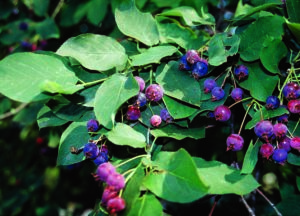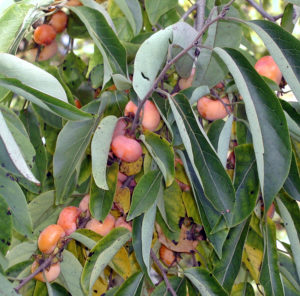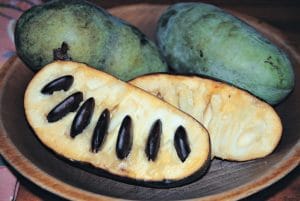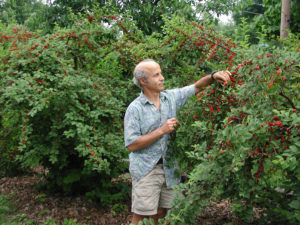Uncommon Fruits with Commercial Potential, Part 2
In my previous article, the first part of this 2-part series, I made a case for growing uncommon fruits: The fruits relative freedom from pests and ease of growth, along with their delicious and unique flavors, make them ideally suited to local markets. I then went on to describe some uncommon fruits — specifically, “fruits with a history” — that I recommend planting. In this second, concluding part of my article, I go on to describe other uncommon fruits that I recommend planting, continuing, for interest, my grouping of them into various categories.
Fruits a Little Finicky About Conditions
Juneberry, also known as shadbush and serviceberry (Amelanchier spp., Zones 3-8), is native in every state. The fruits are a blueberry look-alike but have their own flavor that has the richness and sweetness of a sweet cherry along with a hint of almond.

Although resembling blueberries, juneberries have their own unique, delicious flavor. All photos by Lee Reich.
In fact, juneberry is related to apple and, as such, suffers some similar pest problems. I can’t grow them, but just 4 miles away, a row of them bears good annual crops. A number of varieties have been selected for ornamental and fruiting characteristics. Where juneberries can be grown, they are worth planting; if pests are a problem, rip out the plants. But do give them a try.
Lingonberry (Vaccinium vitis-idaea) thrives only in cooler regions (Zone 4-7). It’s a northern European favorite; merely utter the word “lingonberry” to a Scandinavian and watch their eyes mist up with longing. This evergreen shrub grows less than a foot high and spreads via underground runners to fill in an area.
Lingonberry is finicky about soil conditions. What’s needed is a soil that is very acidic, rich in humus, well-drained, and low in fertility — just like blueberry, a relative. Before planting, check the soil pH and add granular sulfur to bring the pH into the desired range of 4 to 5. Mix some acidic peat moss into each planting hole and then, after planting 18” apart, mulch the ground with a couple of inches of wood shavings or leaves. Drip irrigation or regular watering is usually necessary, especially to get a planting established.
A number of varieties are available. For best fruit production, plant at least two varieties.
Fruits That Could Use Some Breeding
American persimmon (Diospyros virginiana, Zones 6-9) is a wonderful fruit plant. The tree is pest-resistant; it hardly needs pruning; it rarely succumbs to spring freezes (never, for me, after 25 years in a frost pocket). And, the fruit is delicious, like a dried apricot that’s been soaked in water, dipped in honey, and given a dash of spice. From a commercial standpoint, the problem is that the fruit is very fragile, akin to jelly held in a thin skin.

Szukis American persimmon is an early ripening variety for northern regions. All photos by Lee Reich.
Handled very gingerly, American persimmon could have commercial potential for very local sales. The fruit tastes awful until dead ripe, so grow varieties that can ripen with your growing season. Here, near the northern limit for persimmon ripening, my favorites include Szukis and Mohler. Dooley and Yates are also good.
Perhaps the future will bring new varieties that hold up better for marketing. For now, American persimmon is a very fragile, very delicious fruit.
Nanking cherry (Prunus tomentosa, Zone 3-6) is a true cherry that bears prodigious crops for little or no effort on your part. But . . . the fruit is small (1/2-5/8” diameter) and harvesting leaves a tear in the fruit where the stem was attached. This fruit has much potential and a few varieties — now lost — with larger and tastier fruits were developed. Still, run of the mill seedlings, which are readily available, are very tasty and the plants bear quickly and are very pest resistant with little or no care. Cross-pollination is necessary.
Uncommon Fruits for Almost Everywhere
In contrast to American persimmon, Asian persimmon, also known as kaki (D. kaki, Zones 6-10), has been cultivated and bred for thousands of years — in Asia. Kakis are larger and firmer than American persimmons, and can be picked to ripen off the plant. Just a few varieties appear in American markets and those are mostly from California. My farmden is slightly too far north of the northern limit for the hardiest kakis; in Zone 6 and warmer, you can be the only one around with Eureka, Giboshi, Giombo, and Saijo fruits, all of which are delectably sweet.
Hardy kiwifruit (Actinidia arguta, Zones 4-9, A. kolomikta, Zones 3-7), as its name implies, is a cold-hardy relative of the fuzzy, market kiwifruit, which is not hardy. The best thing about hardy kiwifruit, and the way they differ most from market kiwifruits, is in the fruit itself. Hardy kiwifruits have similar flavor and emerald green flesh as their market cousins, but the hardy kiwifruits are grape-size and have smooth skins. Just pop them into your mouth, skin and all, like grapes. Hardy kiwifruit also are sweeter and more aromatic, with hints of additional flavors such as banana, passionfruit, or pineapple. The fruits ripen in autumn, and once they reach a certain stage of maturity, can be stored under refrigeration from which they can be removed and ripened as needed. Anna, Geneva, MSU, and Dumbarton are some good fruiting varieties.
I grow hardy kiwifruit vines on wires strung down the length of a 5-foot-wide T-trellis. Plants are either male or female so you need to plant a separate, nonfruiting male vine to pollinate fruiting females — up to eight females per male. Kiwis are pest-free but do need to be pruned religiously and severely, once in winter and occasionally through summer.
Pawpaw (Asimina triloba, Zones 4-8) is an American native that, although hardy to below -25°F., has many tropical aspirations. The tree looks very tropical, with lush, large leaves. It’s the northernmost member of the mostly tropical custard apple family. And best of all, the fruit tastes and looks tropical. It’s flavor has been likened to banana with mango, pineapple, and avocado mixed in. I liken it to crème brûlée.

Pawpaw has tropical aspirations, with texture and taste of banana along with hints of mango, pineapple, and avocado.
Success with pawpaw begins with a grafted tree of a named variety. In shorter season areas, I recommend the varieties Pennsylvania Golden 1, 2, 3, or 4. The trees grow fifteen to twenty feet high and should be given that same spacing, or a bit less, in full sun. Once a plant is in the ground and growing well, little further care is needed beyond harvesting the fruits — twenty-five to fifty pounds per plant — and occasional winter pruning.
Plants of these uncommon fruits are not as readily available as, say, apple trees, especially if you’re seeking special varieties. A number of nurseries specialize in one or more of these uncommon fruits, and it pays to seek out specialty nurseries for these special plants.
More information on uncommon fruits can be found in the book Uncommon Fruits for Every Garden by Lee Reich (Timber Press, 2004) and by contacting Lee Reich, 845-255-0417 or garden@leereich.com.



would you have any info or opinions on the hsakap or honeyberry for commercial sales?